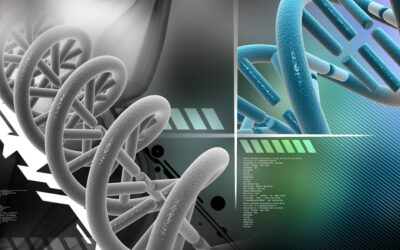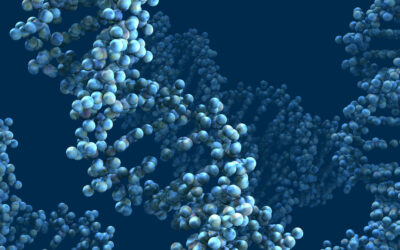The ACE Gene
In the dynamic landscape of personalized fitness, direct-to-consumer (DTC) genetic testing has emerged as a game-changer. The ACE gene has played a central role in DTC genetic testing right from the very start. The ACE gene influences cardiovascular health and also holds a key to understanding the balance between fast-twitch and slow-twitch muscle fibers. In this article, we discuss the connection between the ACE gene and muscle fiber types, exploring how DTC genetic companies leverage this information for personalized fitness insights.
The ACE Gene and Muscle Fiber Dynamics
The ACE gene, or Angiotensin-Converting Enzyme gene, plays a multifaceted role in our genetic makeup, not only affecting cardiovascular health but also influencing our predisposition to fast-twitch and slow-twitch muscle fibers.
One of the most studied polymorphisms in the ACE gene is the insertion/deletion (I/D) polymorphism. This polymorphism refers to the presence (insertion, I) or absence (deletion, D) of a 287-base pair fragment in intron 16 of the ACE gene. The I/D polymorphism has been linked to variations in physical performance, but the relationship is complex and not fully understood. The lack of understanding the mechanism of action, as we will mention continually in this blog, is important in deciding how to use this gene in the context of DTC genetics.
Research has explored the association between the ACE I/D polymorphism and endurance performance. The I allele has been associated with better endurance performance in some studies, while others have found no significant correlation. The underlying mechanisms are not entirely clear, but it has been proposed that the ACE enzyme may influence muscle metabolism and oxygen utilization.
The ACE gene and Muscle Fiber Type
Regarding the fast twitch to slow twitch muscle fiber ratio, it’s important to note that muscle fiber composition is a complex trait influenced by multiple genetic and environmental factors. Genes such as ACTN3 (alpha-actinin-3) have been more directly linked to muscle fiber type. The R577X polymorphism in the ACTN3 gene has been associated with the absence of the alpha-actinin-3 protein in fast twitch muscle fibers.
The ACE gene and DTC Genetic Testing
Fast-Twitch Dominance and Power Performance
The ACE gene is a key player in determining an individual’s predisposition to fast-twitch muscle fibers. DTC genetic testing uses this information to provide insights into power performance potential. Individuals with a genetic inclination towards fast-twitch dominance may excel in activities requiring short bursts of intense effort.
Slow-Twitch Endurance and Stamina
Conversely, the ACE gene also influences the prevalence of slow-twitch muscle fibers. DTC genetic companies leverage this knowledge to offer insights into an individual’s potential for endurance and stamina. Those genetically inclined towards slow-twitch dominance may thrive in activities requiring sustained effort over extended periods.
Tailored Exercise Regimens
Armed with insights from the ACE gene, DTC genetic testing provides users with personalized exercise regimens. Whether it’s optimizing strength training for fast-twitch dominance or tailoring cardio workouts for slow-twitch endurance, these recommendations empower individuals to align their fitness routines with their unique genetic blueprint.
The Future of Genetic Fitness and ACE
The ACE gene not only guides us in understanding cardiovascular health but also unlocks the secrets to our muscle fiber composition. DTC genetic testing companies harness the power of this gene to provide users with personalized fitness insights, offering a roadmap to optimizing workouts based on the delicate interplay between fast-twitch and slow-twitch muscle fibers. As we delve deeper into our genetic fitness code, the ACE gene takes center stage, illuminating the path to a personalized and powerful fitness journey.
List of Resources on ACE and DTC Testing
- Bouchard, C., An, P., Rice, T., Skinner, J. S., Wilmore, J. H., Gagnon, J., … & Rao, D. C. (1999). Familial aggregation of VO(2 max) response to exercise training: results from the HERITAGE Family Study. Journal of Applied Physiology, 87(3), 1003-1008.
- Bray, M. S., Hagberg, J. M., Perusse, L., Rankinen, T., Roth, S. M., Wolfarth, B., … & Bouchard, C. (2009). The human gene map for performance and health-related fitness phenotypes: the 2006–2007 update. Medicine and Science in Sports and Exercise, 41(1), 35-73.
- Myerson, S., Hemingway, H., Budget, R., Martin, J., Humphries, S., & Montgomery, H. (1999). Human angiotensin I-converting enzyme gene and endurance performance. Journal of Applied Physiology, 87(4), 1313-1316.
- Rankinen, T., Wolfarth, B., Simoneau, J. A., Maier-Lenz, D., Rauramaa, R., Rivera, M. A., … & Bouchard, C. (2000). No association between the angiotensin-converting enzyme ID polymorphism and elite endurance athlete status. Journal of Applied Physiology, 88(5), 1571-1575.
- Puthucheary, Z., Skipworth, J. R., Rawal, J., Loosemore, M., Van Someren, K., & Montgomery, H. E. (2011). The ACE gene and human performance: 12 years on. Sports Medicine, 41(6), 433-448.
- Williams, A. G., Day, S. H., Folland, J. P., & Gohlke, P. (2005). Dhamrait, S., Payne, J. R., … & Williams, A. G. (2005). The angiotensin converting enzyme gene I/D polymorphism: associations with VO2max in English active men. Journal of Sports Sciences, 23(10), 1085-1092.
- Ahmetov, I. I., Druzhevskaya, A. M., & Astratenkova, I. V. (2008). ACE and NOS3 gene polymorphisms and exercise-induced muscle damage in non-athletic men. European Journal of Applied Physiology, 103(6), 631-638.
- Scott, R. A., Moran, C., Wilson, R. H., Onywera, V., Boit, M. K., Goodwin, W. H., … & Pitsiladis, Y. P. (2005). No association between angiotensin converting enzyme (ACE) gene variation and endurance athlete status in Kenyans. Comparative Biochemistry and Physiology Part A: Molecular & Integrative Physiology, 141(2), 169-175.
- Montgomery, H. E., Clarkson, P., Dollery, C. M., Prasad, K., Losi, M. A., Hemingway, H., … & Maseri, A. (1997). Association of angiotensin-converting enzyme gene I/D polymorphism with change in left ventricular mass in response to physical training. Circulation, 96(3), 741-747.
- Wang, G., Mikami, E., Chiu, L. L., De Perini, A., Deason, M., Fuku, N., … & Pitsiladis, Y. (2013). Association analysis of ACE and ACTN3 in elite Caucasian and East Asian swimmers. Medicine and Science in Sports and Exercise, 45(5), 892-900.
- Ma, F., Yang, Y., Li, X., Zhou, F., Gao, C., Li, M., … & Yang, X. (2013). The association of sport performance with ACE and ACTN3 genetic polymorphisms: a systematic review and meta-analysis. PloS One, 8(1), e54685.
- Denham, J., Marques, F. Z., O’Brien, B. J., & Charchar, F. J. (2013). Exercise: putting action into our epigenome. Sports Medicine, 43(3), 189-209.
- Ahmetov, I. I., & Fedotovskaya, O. N. (2015). Current progress in sports genomics. Advances in Clinical Chemistry, 70, 247-314.
- Pitsiladis, Y. P., Tanaka, M., Eynon, N., Bouchard, C., North, K. N., Williams, A. G., & Collins, M. (2016). Athlome Project Consortium: a concerted effort to discover genomic and other “omic” markers of athletic performance. Physiological Genomics, 48(3), 183-190.
- Fedotovskaya, O. N., & Ahmetov, I. I. (2017). Current insights in genetics of human movement behaviour: Implications for sport talent identification and development. Biology of Sport, 34(3), 227.
- Ma, F., Yang, Y., Li, X., Zhou, F., Gao, C., Li, M., … & Yang, X. (2013). The association of sport performance with ACE and ACTN3 genetic polymorphisms: a systematic review and meta-analysis. PloS One, 8(1), e54685.
- Charbonneau, D. E., Hanson, E. D., Ludlow, A. T., Delmonico, M. J., & Hurley, B. F. (2008). ACE genotype and the muscle hypertrophic and strength responses to strength training. Medicine and Science in Sports and Exercise, 40(4), 677-683.
- Delmonico, M. J., Kostek, M. C., Doldo, N. A., Hand, B. D., Walsh, S., Conway, J. M., … & Hurley, B. F. (2007). Alpha-actinin-3 (ACTN3) R577X polymorphism influences knee extensor peak power response to strength training in older men and women. Journal of Gerontology: Biological Sciences, 62(2), 206-212.
- Jones, A., Montgomery, H. E., Woods, D. R., Mulcahy, B., & Donnelly, M. (2001). Angiotensin-converting enzyme gene insertion/deletion polymorphism and muscle strength and size response to resistance training. Journal of Applied Physiology, 91(1), 288-294.
- Kikuchi, N., Yoshida, S., Min, S. K., Lee, J. Y., & Kim, J. H. (2017). Association between angiotensin-converting enzyme gene polymorphisms and exercise performance in patients with intermittent claudication. The Korean Journal of Physiology & Pharmacology, 21(5), 563.
- Puthucheary, Z., Skipworth, J. R., Rawal, J., Loosemore, M., Van Someren, K., & Montgomery, H. E. (2011). The ACE gene and human performance: 12 years on. Sports Medicine, 41(6), 433-448.
- Ahmetov, I. I., & Fedotovskaya, O. N. (2015). Current progress in sports genomics. Advances in Clinical Chemistry, 70, 247-314.
- Charbonneau, D. E., Hanson, E. D., Ludlow, A. T., Delmonico, M. J., & Hurley, B. F. (2008). ACE genotype and the muscle hypertrophic and strength responses to strength training. Medicine and Science in Sports and Exercise, 40(4), 677-683.
- Jones, A., Montgomery, H. E., Woods, D. R., Mulcahy, B., & Donnelly, M. (2001). Angiotensin-converting enzyme gene insertion/deletion polymorphism and muscle strength and size response to resistance training. Journal of Applied Physiology, 91(1), 288-294.
- Delmonico, M. J., Kostek, M. C., Doldo, N. A., Hand, B. D., Walsh, S., Conway, J. M., … & Hurley, B. F. (2007). Alpha-actinin-3 (ACTN3) R577X polymorphism influences knee extensor peak power response to strength training in older men and women. Journal of Gerontology: Biological Sciences, 62(2), 206-212.





